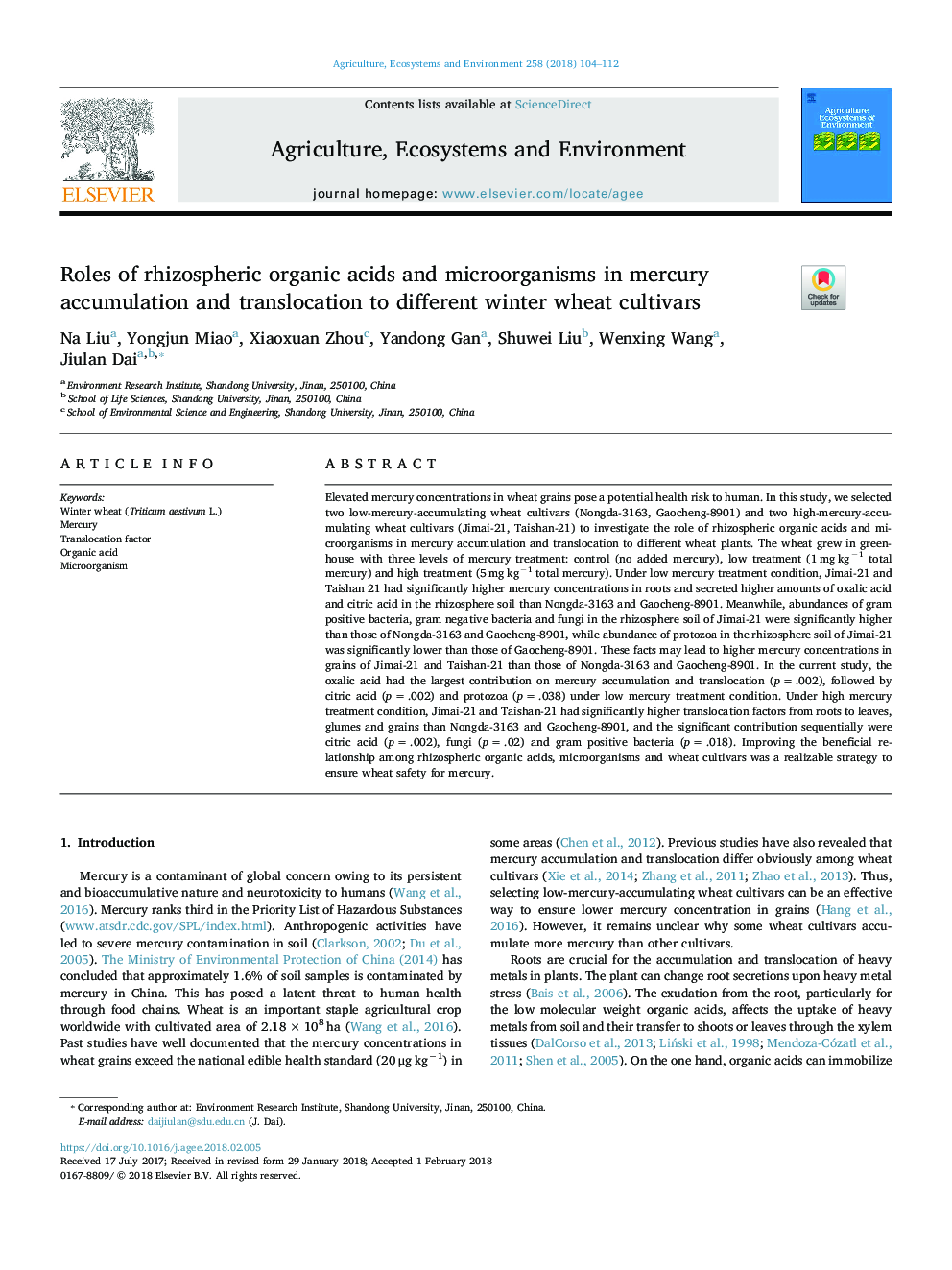| کد مقاله | کد نشریه | سال انتشار | مقاله انگلیسی | نسخه تمام متن |
|---|---|---|---|---|
| 8487119 | 1551994 | 2018 | 9 صفحه PDF | دانلود رایگان |
عنوان انگلیسی مقاله ISI
Roles of rhizospheric organic acids and microorganisms in mercury accumulation and translocation to different winter wheat cultivars
ترجمه فارسی عنوان
نقش اسید های ارجحیت ریزوسفر و میکروارگانیسم ها در تجمع و انتقال جیوه به ارقام مختلف گندم زمستانه
دانلود مقاله + سفارش ترجمه
دانلود مقاله ISI انگلیسی
رایگان برای ایرانیان
کلمات کلیدی
موضوعات مرتبط
علوم زیستی و بیوفناوری
علوم کشاورزی و بیولوژیک
علوم زراعت و اصلاح نباتات
چکیده انگلیسی
Elevated mercury concentrations in wheat grains pose a potential health risk to human. In this study, we selected two low-mercury-accumulating wheat cultivars (Nongda-3163, Gaocheng-8901) and two high-mercury-accumulating wheat cultivars (Jimai-21, Taishan-21) to investigate the role of rhizospheric organic acids and microorganisms in mercury accumulation and translocation to different wheat plants. The wheat grew in greenhouse with three levels of mercury treatment: control (no added mercury), low treatment (1â¯mgâ¯kgâ1 total mercury) and high treatment (5â¯mgâ¯kgâ1 total mercury). Under low mercury treatment condition, Jimai-21 and Taishan 21 had significantly higher mercury concentrations in roots and secreted higher amounts of oxalic acid and citric acid in the rhizosphere soil than Nongda-3163 and Gaocheng-8901. Meanwhile, abundances of gram positive bacteria, gram negative bacteria and fungi in the rhizosphere soil of Jimai-21 were significantly higher than those of Nongda-3163 and Gaocheng-8901, while abundance of protozoa in the rhizosphere soil of Jimai-21 was significantly lower than those of Gaocheng-8901. These facts may lead to higher mercury concentrations in grains of Jimai-21 and Taishan-21 than those of Nongda-3163 and Gaocheng-8901. In the current study, the oxalic acid had the largest contribution on mercury accumulation and translocation (pâ¯=â¯.002), followed by citric acid (pâ¯=â¯.002) and protozoa (pâ¯=â¯.038) under low mercury treatment condition. Under high mercury treatment condition, Jimai-21 and Taishan-21 had significantly higher translocation factors from roots to leaves, glumes and grains than Nongda-3163 and Gaocheng-8901, and the significant contribution sequentially were citric acid (pâ¯=â¯.002), fungi (pâ¯=â¯.02) and gram positive bacteria (pâ¯=â¯.018). Improving the beneficial relationship among rhizospheric organic acids, microorganisms and wheat cultivars was a realizable strategy to ensure wheat safety for mercury.
ناشر
Database: Elsevier - ScienceDirect (ساینس دایرکت)
Journal: Agriculture, Ecosystems & Environment - Volume 258, 15 April 2018, Pages 104-112
Journal: Agriculture, Ecosystems & Environment - Volume 258, 15 April 2018, Pages 104-112
نویسندگان
Na Liu, Yongjun Miao, Xiaoxuan Zhou, Yandong Gan, Shuwei Liu, Wenxing Wang, Jiulan Dai,
